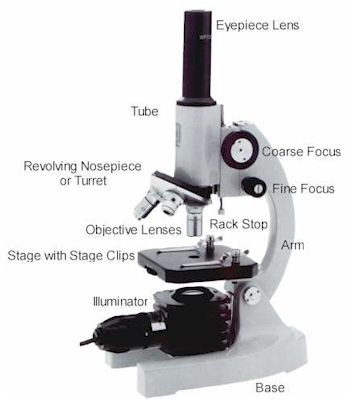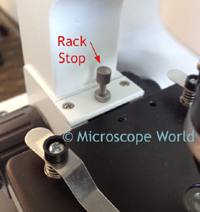This Is the Part Where You Look at the Art
Microscope Parts & Specifications

Historians credit the invention of the compound microscope to the Dutch spectacle maker, Zacharias Janssen, effectually the twelvemonth 1590 (more than history here). The compound microscope uses lenses and light to enlarge the epitome and is also called an optical or lite microscope (versus an electron microscope). The simplest optical microscope is the magnifying glass and is good to nigh x times (10x) magnification.
The compound microscope has two systems of lenses for greater magnification:
one. Ocular eyepiece lens to wait through.
2. Objective lens, closest to the object. Before purchasing or using a compound microscope, it is of import to know the functions of each part. This information is presented beneath. Links will take yous to additional information and images.
The Functions & Parts of a Microscope
Eyepiece Lens: the lens at the pinnacle that you look through, usually 10x or 15x power.
Tube: Connects the eyepiece to the objective lenses.
Arm: Supports the tube and connects information technology to the base.
Base: The bottom of the microscope, used for support.
Illuminator: A steady lite source (110 volts) used in identify of a mirror. If your microscope has a mirror, it is used to reflect light from an external calorie-free source upwards through the lesser of the stage.
Phase with Phase Clips: The apartment platform where you lot place your slides. Phase clips hold the slides in place. If your microscope has a mechanical stage, you volition exist able to motion the slide around by turning ii knobs. I moves it left and right, the other moves it upward and downwardly.
Revolving Nosepiece or Turret: This is the part of the microscope that holds two or more objective lenses and can be rotated to easily change ability.
Objective Lenses: Ordinarily yous volition notice 3 or iv objective lenses on a microscope. They near always consist of 4x, 10x, 40x and 100x powers. When coupled with a 10x (most common) eyepiece lens, total magnification is 40x (4x times 10x), 100x , 400x and 1000x. To have good resolution at 1000x, yous volition need a relatively sophisticated microscope with an Abbe condenser. An Abbe condenser is composed of 2 lenses that control the light that passes through the specimen before entering the objective lens on the microscope. The shortest lens is the everyman power, the longest i is the lens with the greatest power. Lenses are colour coded and if built to DIN standards are interchangeable between microscopes. "DIN" is an abbreviation of "Deutsche Industrial Normen". This is a German standard that has been adopted internationally every bit an optical standard used in about quality microscopes. A typical DIN standard microscope objective lens has a 0.7965" (xx.1mm) diameter threads, 36 TPI (threads per inch), and a 55º Whitworth. Many high power objective lenses are retractable (i.e. 40XR). This means that if they hit a slide, the end of the lens will push in (spring loaded) thereby protecting the lens and the slide. All proficient quality microscopes accept achromatic, parcentered, parfocal lenses.
 Rack Stop: This is an adjustment that determines how close the objective lens can become to the slide. It is set at the factory and keeps students from cranking the loftier power objective lens downward into the slide and breaking things. You would only need to arrange this if you were using very thin slides and y'all weren't able to focus on the specimen at high power. (Tip: If you are using sparse slides and can't focus, rather than adjust the rack stop, place a clear glass slide under the original slide to heighten it a bit higher).
Rack Stop: This is an adjustment that determines how close the objective lens can become to the slide. It is set at the factory and keeps students from cranking the loftier power objective lens downward into the slide and breaking things. You would only need to arrange this if you were using very thin slides and y'all weren't able to focus on the specimen at high power. (Tip: If you are using sparse slides and can't focus, rather than adjust the rack stop, place a clear glass slide under the original slide to heighten it a bit higher).
Condenser Lens: The purpose of the condenser lens is to focus the light onto the specimen. Condenser lenses are almost useful at the highest powers (400x and higher up). Microscopes with in-stage condenser lenses render a sharper image than those with no lens (at 400x). If your microscope has a maximum ability of 400x, you volition become the maximum benefit by using a condenser lenses rated at 0.65 NA or greater. 0.65 NA condenser lenses may be mounted in the phase and piece of work quite well. A big advantage to a stage mounted lens is that there is ane less focusing item to deal with. If yous go to 1000x so you should have a condenser lens with an Northward.A. of 1.25 or greater. All of our 1000x microscopes use 1.25 Abbe condenser lens systems. The Abbe condenser lens tin can be moved up and down. It is fix very close to the slide at 1000x and moved further away at the lower powers.
Diaphragm or Iris: Many microscopes have a rotating disk under the stage. This diaphragm has different sized holes and is used to vary the intensity and size of the cone of light that is projected upwards into the slide. There is no set up dominion regarding which setting to apply for a particular power. Rather, the setting is a function of the transparency of the specimen, the caste of contrast you desire and the item objective lens in use.
How to Focus Your Microscope: The proper way to focus a microscope is to start with the lowest ability objective lens first and while looking from the side, crank the lens down as close to the specimen equally possible without touching it. Now, look through the eyepiece lens and focus upward only until the image is precipitous. If yous can't go it in focus, repeat the process again. In one case the image is precipitous with the low ability lens, you should exist able to simply click in the next ability lens and practise pocket-size adjustments with the focus knob. If your microscope has a fine focus adjustment, turning information technology a bit should exist all that's necessary. Keep with subsequent objective lenses and fine focus each fourth dimension.
If y'all are unsure of the parts and functions of your microscope, contact Microscope World.
This page has activities and complimentary printouts for labeling parts of the microscope.
Related Articles:
Microscope Objective Lenses
Types of Microscopes
Infographic on the History of the Microscope
Source: https://www.microscopeworld.com/t-parts.aspx
0 Response to "This Is the Part Where You Look at the Art"
Post a Comment